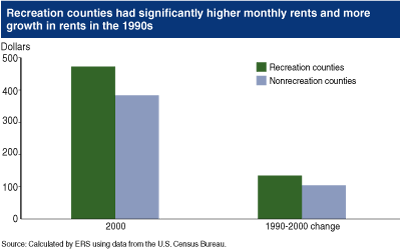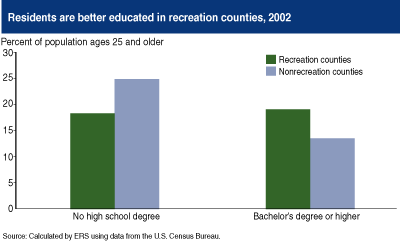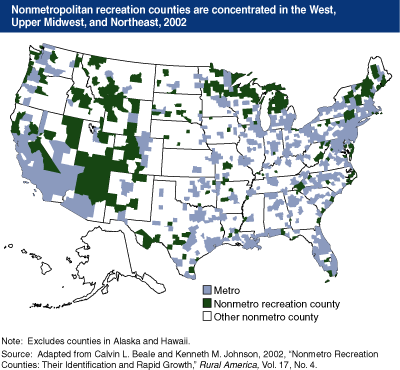Rural Areas Benefit From Recreation and Tourism Development
- by Richard Reeder and Dennis Brown
- 9/1/2005
Beautiful scenery—lakes, mountains, forests—attracts people to rural resort areas in the United States. Rural recreation areas have grown rapidly in recent years, and recreation and tourism development has become a popular vehicle for rural economic development. Recreation development involves more than just tourist-related businesses, such as hotels and restaurants; it encompasses all economic growth that results from people moving into the community to take advantage of its recreational amenities. This kind of development has the potential to dramatically transform a stagnant rural community into a thriving community by attracting retirees, entrepreneurs, and young workers, diversifying the economy, and improving the quality of life with a broader array of goods and services.
But recreation development comes with potential problems. Some problems are growth-related—such as congested roads, crowded schools, environmental strains, housing shortages, despoiled scenic views, and conflicts over land use and public policies. Other problems are specific to the tourism industry's workers (unskilled or foreign), many of whom earn relatively little and have few fringe benefits. And another downside: Criminals may be particularly attracted to some recreation areas.
Is recreation and tourism development a viable economic option for rural areas? ERS examined some key questions about the socioeconomic effects of rural recreation development. The answers are generally favorable, with improved employment conditions, earnings, and incomes; lower poverty rates; and healthier and better educated populations. However, conditions vary by type of recreation area, and higher housing costs and crime rates can accompany the more favorable outcome (see box 'Definitions and Methodology').
More Work, Higher Earnings
Because of rapid employment growth in rural recreation areas and a potentially broader array of jobs, including more seasonal and part-time positions that appeal to residents unable to work full-time, year-round jobs, employment options would likely be enhanced by recreation development. However, it may not be easier for residents to find jobs due to competition with other workers who have recently moved to the area.
ERS researchers found that recreation development, measured by the extent to which a county's employment, income, and housing depend on recreation and tourism, is linked to a higher percentage of the working-age population having jobs. This percentage-employed measure encompasses discouraged workers who had dropped out of the labor force, making it a more comprehensive and meaningful measure of employment conditions. Moreover, recreation development led to an increase in this employment measure during the 1990s for all age groups, except the population ages 65 and older.
Jobs that are usually associated with recreation development, such as those in hotels and restaurants, are assumed to be low paying with few fringe benefits. Some related service jobs, such as those in retail businesses, may also pay low wages. However, low-wage workers in recreation areas may have access to more opportunities to work part-time and seasonal jobs to supplement their incomes, and some service and construction jobs associated with recreation development pay quite well.
Recreation development appears to have increased the growth in earnings per job during the 1990s. But average earnings per job in 2000 were not significantly higher in rural recreation areas. To better measure what residents earn from employment, ERS looked at total earnings per resident worker, which includes earnings from second jobs (part-time and seasonal). Second jobs are expected to be more readily available in recreation counties than elsewhere. Total earnings per resident were substantially higher ($2,000 more per worker) in recreation counties than in other rural counties. Contrary to conventional wisdom, recreation development seems to have increased residents' earnings.
Cost of Living Higher, Better Education and Health
Anecdotal evidence suggests that housing costs have risen rapidly in some of the most well-known recreation areas, becoming so high that many workers can no longer afford to live in the area, sometimes requiring long commutes. In addition, higher housing costs may prevent the children and grandchildren of some long-term residents from finding housing in their home towns. While this may be true in some recreation areas, it is not known how widespread this higher cost of living is.
However, median rent for housing (an important component in cost of living) in recreation counties is 23 percent higher than in other nonmetropolitan (nonmetro) counties, reducing some of the economic advantages for recreation county residents, but only partially. Median household incomes are $3,185 higher in recreation counties than in other counties, while median annual rent is only $1,080 higher in recreation counties. This implies that the higher rent offsets about a third of the recreation county income advantage.
Recreational development might attract migrants who tend to have higher levels of education than nonmigrants. As expected, ERS research found that recreational development leads to a more educated population, particularly when education is measured by the share of adults with college degrees.
Recreation development is also associated with good health (measured by age-adjusted death rates), as might be expected from the higher number of physicians (per 100,000 residents) in recreation counties than in other rural counties. The availability of physicians, however, was not responsible for the good health of residents. Other factors, such as greater opportunities for physical exercise, may explain the health advantages associated with recreation development. In addition, the pristine environments of many recreation counties, with clean air and water, might lead to better overall health.
More Crime, Other Social Problems
When recreation development is unplanned or occurs too rapidly, it can lead to congested roads and can strain the capacity of public services. Recreation areas have significantly higher rates of population growth than other rural areas, suggesting that some growth-related social problems, such as school crowding, housing shortages, pollution, and loss of identification with the community, may be present. ERS researchers examined road congestion by looking at commute times and found that recreation development was not linked to the commute time to work in 2000. If anything, recreation development appears to have helped keep down commute times in recent years because recreation counties had smaller increases in average commute times during the 1990s than other rural counties.
Recreation development can also result in higher poverty rates if significant numbers of low-wage, low-skilled workers arrive to work in tourist-related service establishments. However, ERS research indicates that recreation development results in significantly lower levels of poverty in rural recreation areas. In addition, recreation and tourism development appears to have contributed to declines in local poverty rates during the 1990s.
Another possible disadvantage is higher crime rates: Criminals may be drawn to recreation communities to prey on tourists, or certain types of recreation, such as casino gambling, could attract illicit activity. Crime rates (for serious crimes) are higher in recreation counties than in other rural counties. However, the way crime rates are calculated may be biased inherently against recreation areas. Crimes against tourists and seasonal residents are counted in the crime statistics, but tourists and seasonal residents are not counted as part of the population base upon which the crime rates are calculated. Thus, even if people in recreation areas do not have a higher chance of becoming victims of crimes, the crime rates for these areas will appear higher than elsewhere because of this bias. Nevertheless, one could still argue that recreation-related crime adds to the local cost of policing and incarcerating criminals, just like recreation-related traffic adds to the cost of maintaining roads.
Conditions Vary From Place to Place
The benefits of recreation development for rural areas appear to be generally positive. This finding, along with the finding that socioeconomic effects vary significantly from one place to another, will inform policymakers seeking to achieve meaningful development through this strategy.
The rural recreation counties in this analysis exhibit a considerable degree of diversity in socioeconomic conditions. For example, counties with ski resorts have among the wealthiest, best educated, and healthiest populations among all recreation county types. These counties also have relatively high crime rates. In contrast, counties with reservoir-based recreation facilities (mainly located in parts of the Great Plains and the Midwest) and recreation counties in the southern Appalachian region have among the poorest, least educated residents among all recreation county types and relatively high age-adjusted death rates, but they have relatively low crime rates.
Counties with casino facilities had among the highest rates of job growth and large increases in earnings per job during the 1990s. Casino counties also had among the highest rates of growth in the share of employed people ages 65 and older, perhaps reflecting the greater need for jobs among older people in these high-poverty communities. Because recreation county types are not evenly distributed across the country, some of the differences may reflect interregional diversity.
This analysis focused on counties that have already succeeded in developing recreation as a significant industry. Most of these places have amenities that attract people. In contrast, some places that employ recreation as a development strategy may encounter difficulties because they lack natural amenities or other attributes that can attract large numbers of people. In these less attractive places, the socioeconomic benefits of recreation development are likely to be smaller.
This article is drawn from:
- Reeder, R. & Brown, D. (2005). Recreation, Tourism, and Rural Well-Being. U.S. Department of Agriculture, Economic Research Service. ERR-7.




